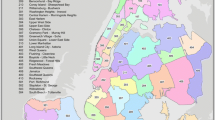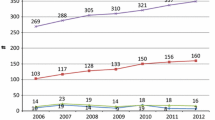Abstract
Places with active HIV transmission may serve as key locations for targeted control. In 2008–2009, heterosexual sex partner venues in Baltimore, MD were identified using a three-phase process and characterized by the presence or absence of HIV cases. 1,594 participants aged 18–35 years were enrolled at 87 venues. The study yielded an overall HIV prevalence of 3.7 %; 42 % of venues had ≥1 case of HIV (i.e., HIV positive venues). In final age-adjusted models, HIV positive venues had 10 % more high HIV-risk sexual partnering (95 % CI 1.01, 1.19) and more than twice as much drug market activity (95 % CI 1.04, 6.46) compared to HIV negative venues. Commercial sex work, parenteral risk behavior and venue-level sex market activity were not significantly associated with HIV status of the venues. This study highlights characteristics of venues, such as drug market activity, that may be important in identifying places with active HIV transmission.
Resumen
Los lugares con transmisión activa de infección por SIDA pueden servir como lugares claves para un control enfocado. De 2008 a 2009, utilizando un proceso de tres fases, fueron identificados lugares de interacción de parejas sexuales heterosexuales en Baltimore, MD y fueron caracterizados por la presencia o ausencia de casos de VIH. Se inscribieron 1,594 participantes en 87 lugares de interacción con edades comprendidas entre los 18 y los 35 años. El estudio mostró una prevalencia general de SIDA de 3.7 %; 42 % de los lugares tenía ≥1 caso de VIH (es decir, lugares con infección de VIH). En los últimos modelos ajustados por edad, los lugares con infección del VIH tenían 10 % más uniones sexuales de alto riesgo de VIH (95 % CI 1.01, 1.19) y más del doble de actividad de tráfico de drogas (95 % CI 1.04, 6.46) comparados con los lugares que no tienen infección de VIH. El trabajo sexual comercial, conducta de riesgo parenteral y actividad en el mercado del sexo en un determinado lugar no estaban asociados de una manera significativa con el estatus de VIH de los lugares. Este estudio destaca las características de los lugares de interacción, como el comercio de drogas, que podría ser importante para identificar los lugares con transmisión activa de infección por VIH.

Similar content being viewed by others
References
Hall HI, Song R, Rhodes P, et al. Estimation of HIV incidence in the United States. JAMA. 2008;300(5):520–9.
Rosenberg PS, Biggar RJ. Trends in HIV incidence among young adults in the United States. JAMA. 1998;279(23):1894–9.
Galbraith JS, Stanton B, Boekeloo B, et al. Exploring implementation and fidelity of evidence-based behavioral interventions for HIV prevention: lessons learned from the focus on kids diffusion case study. Health Educ Behav. 2009;36(3):532–49.
Ellen JM. The next generation of HIV prevention for adolescent females in the United States: Linking behavioral and epidemiologic sciences to reduce incidence of HIV. J Urban Health. 2003;80(4 Suppl 3):iii40–9.
DeGruttola V, Smith DM, Little SJ, Miller V. Developing and evaluating comprehensive HIV infection control strategies: issues and challenges. Clin Inf Dis. 2010;50(Suppl 3):S102–7.
Lasry A, Sansom SL, Hicks KA, Uzunangelov V. A model for allocating CDC’s HIV prevention resources in the United States. Health Care Manag Sci. 2011;14(1):115–24.
The White House Office of National AIDS Policy. National HIV/AIDS strategy for the United States. Washington, DC: The White House; 2010.
Polk S, Ellen JM, Fichtenberg C, Huettner S, Jennings JM. HIV prevalence overall and among high HIV-risk behaviorally-defined subgroups among heterosexuals at community-based venues in a Mid-Atlantic, U.S. city. J Urban Health. 2013;90(4):747–57.
Jennings JM, Taylor R, Iannacchione VG, et al. The available pool of sex partners and risk for a current bacterial sexually transmitted infection. Ann Epidemiol. 2010;20(7):532–8.
Jennings JM, Taylor RB, Salhi RA, Furr-Holden CD, Ellen JM. Neighborhood drug markets: a risk environment for bacterial sexually transmitted diseases among urban youth. Soc Sci Med. 2012;74(8):1240–50.
Denning P, DiNenno E. Communities in crisis: is there a generalized HIV epidemic in impoverished urban areas of the United States? 2010.
Weir SS, Pailman C, Mahlalela X, Coetzee N, Meidany F, Boerma JT. From people to places: focusing AIDS prevention efforts where it matters most. AIDS. 2003;17(6):895–903.
Michaud JM, Johnson SM, Ellen J. Comparison of sex partner meeting venues and residences of syphilis cases in Baltimore. Sex Transm Dis. 2004;31(4):239–42.
Wawer MJ, Gray RH, Sewankambo NK, et al. Rates of HIV-1 transmission per coital act, by stage of HIV-1 infection, in Rakai. Uganda. J Infect Dis. 2005;191(9):1403–9.
Pilcher CD, Tien HC, Eron JJ Jr, et al. Brief but efficient: acute HIV infection and the sexual transmission of HIV. J Infect Dis. 2004;189(10):1785–92.
Quinn TC, Wawer MJ, Sewankambo N, et al. Viral load and heterosexual transmission of human immunodeficiency virus type 1. Rakai project study group. N Engl J Med. 2000;342(13):921–9.
Cohen MS, Pilcher CD. Amplified HIV transmission and new approaches to HIV prevention. J Infect Dis. 2005;191(9):1391–3.
Brenner BG, Roger M, Routy JP, et al. High rates of forward transmission events after acute/early HIV-1 infection. J Infect Dis. 2007;195(7):951–9.
Weir SS, Tate JE, Zhusupov B, Boerma JT. Where the action is: monitoring local trends in sexual behavior. Sex Transm Infect. 2004;80(Suppl 2):ii63–8.
Simon D, Burns E. The corner: a year in the life of an inner-city neighborhood. 1st ed. New York: Broadway Books; 1997.
Agar M, Reisinger H. Numbers and patterns: heroin indicators and what they represent. Hum Organ. 1999;58:365–74.
Gleghorn AA, Jones TS, Doherty MC, Celentano DD, Vlahov D. Acquisition and use of needles and syringes by injecting drug users in Baltimore, Maryland. J Acquir Immune Defic Syndr Hum Retrovirol. 1995;10(1):97–103.
United States Census Bureau. Census 2000, summary file 3 (SF 3). http://www.geolytics.com/Default.asp. Updated 2003. Accessed Feb 12, 2003.
Doherty MC, Garfein RS, Monterroso E, Brown D, Vlahov D. Correlates of HIV infection among young adult short-term injection drug users. AIDS. 2000;14(6):717–26.
Mehta SH, Galai N, Astemborski J, et al. HIV incidence among injection drug users in Baltimore, Maryland (1988-2004). J Acquir Immune Defic Syndr. 2006;43(3):368–72.
Vlahov D, Anthony JC, Munoz A, et al. The ALIVE study, a longitudinal study of HIV-1 infection in intravenous drug users: description of methods and characteristics of participants. NIDA Res Monogr. 1991;109:75–100.
Craig T. Drugs worsen in city, U.S. says: Traffic in cocaine, heroin, ecstasy assessed by DEA. Baltimore Sun. 2000.
Associated Press. Baltimore leads in ER cases tied to drugs. Baltimore Sun. 1998.
United States National Drug Intelligence Center. Heroin in the northeast. 2003.
Centers for Disease Control and Prevention. Diagnoses of HIV infection among adults and adolescents, by sex and age group, 2008-37 states and 5 U.S. dependent areas. http://www.cdc.gov/hiv/topics/surveillance/resources/slides/adolescents/slides/Adolescents_6.pdf.
MacKellar DA, Gallagher KM, Finlayson T, Sanchez T, Lansky A, Sullivan PS. Surveillance of HIV risk and prevention behaviors of men who have sex with men–a national application of venue-based, time-space sampling. Public Health Rep. 2007;122(Suppl 1):39–47.
Fenner F. A successful eradication campaign. Global eradication of smallpox. Rev Infect Dis. 1982;4(5):916–30.
Kahn JG. The cost-effectiveness of HIV prevention targeting: how much more bang for the buck? Am J Public Health. 1996;86(12):1709–12.
Cohen MS, Chen YQ, McCauley M, et al. Prevention of HIV-1 infection with early antiretroviral therapy. N Engl J Med. 2011;365(6):493–505.
Towe VL, Sifakis F, Gindi RM, et al. Prevalence of HIV infection and sexual risk behaviors among individuals having heterosexual sex in low income neighborhoods in Baltimore, MD: the BESURE study. J Acquir Immune Defic Syndr. 2010;53(4):522–8.
Brookmeyer R, Konikoff J, Laeyendecker O, Eshleman SH. Estimation of HIV incidence using multiple biomarkers. Am J Epidemiol. 2013;177:264–72.
Acknowledgments
The authors thank the men and women who participated in this study and the staff who collected the data. This study was supported by funding from the National Institute of Child Health and Human Development (R21 HD052438) and the National Institute of Drug Abuse (KO1 DA022298-01A1). Meeting at which data were presented: National STD Prevention Conference, Centers for Disease Control and Prevention, Atlanta, GA, 2011.
Author information
Authors and Affiliations
Corresponding author
Rights and permissions
About this article
Cite this article
Polk, S., Ellen, J.M., Fichtenberg, C. et al. Identifying and Characterizing Places for the Targeted Control of Heterosexual HIV Transmission in Urban Areas. AIDS Behav 18, 1476–1482 (2014). https://doi.org/10.1007/s10461-013-0691-x
Published:
Issue Date:
DOI: https://doi.org/10.1007/s10461-013-0691-x




